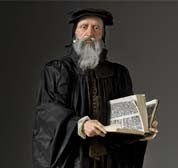Who Was St. Nicholas?
Pastor Kevin DeYoung attempts to flesh-out this question at the TGC blog. In the post he discusses the historical person, the myths, and the transition to Santa. He also provides some thoughts on celebrating the holiday. Here’s an excerpt . . .
In honor of St. Nicholas the gift giver, Christians began to celebrate December 6 (his feast day) by giving presents. The tradition developed over time. For good boys and girls, St. Nicholas would come in his red Bishop’s robe and fill boots with gifts on the night of December 5. For bad boys and girls St. Nicholas was to be feared. In highly catholic parts of Europe, St. Nicholas became a deterrent to erring young children. In Germany, he was often accompanied by Knecht Ruprecht (farmhand Rupert) who threatened to eat misbehaving children. In Switzerland, St. Nicholas threatened to put wicked children in a sack and bring them back to the Black Forest. In the Netherlands, St. Nicholas’ helper would tie them in a sack and bring them back to Spain. In parts of Austria, the priest, dressed up in Christmas garb, would visit the homes of naughty children and threaten them with rod-beatings. At least nowadays, he only checks his list!
Not surprisingly, the Reformers were less than friendly towards the traditions that had been built up around the saints. Luther rejected the saints’ days, believing they were built upon legends and superstitions (and a virulent strain of moralism we might add). In Germany, Luther replaced Saint Nicholas’ Day with a different holiday, Christ Child, or Christkindl. Ironically, Kriss Kringle which derived from Luther’s Christ Child holiday, has become just another name for St. Nicholas.
The cult of St. Nicholas virtually disappeared in Protestant Europe, with the exception of one country: the Netherlands. If you love Christmas with all the trappings of Santa Claus and stockings and presents, thank the Dutch. If you despise all that, try to ignore my last name for the time being. The Puritans had done away with St. Nicholas and banned Christmas altogether. But the Dutch held on to their tradition and brought it with them to the New World. In the Netherlands Sint Nicolaas was contracted to Sinterklaas. According to Dutch tradition, Sinterklaas rides a horse and is accompanied by Zwarte Piet, or Black Pete. Many people figure black Pete was derived from black slaves, although others counter and say that he is black because he goes down the chimney and gets a face full of soot.
At any rate, it is easy to see how Sinterklaas evolved in America to Santa Claus. Santa Claus became the Santa we know in the United States only after the poem “Twas the Night Before Christmas” was written in 1823. Possibly the best known verses ever written by an American, the poem has greatly influenced the tradition of Santa in the English speaking world and beyond.
You can read the rest here.
--The Catechizer
Labels: History





0 Comments:
Post a Comment
<< Home